|
New York Architecture Images- Central Park Ladies Pavilion |
|
|
architect |
Jacob Wrey Mould |
|
location |
|
|
date |
1871 |
|
style |
High Victorian Gothic |
|
construction |
Cast Iron |
|
type |
Utility |
|
|
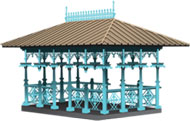 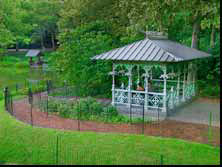 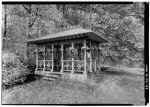 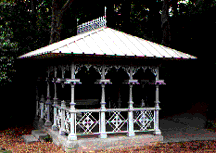 |
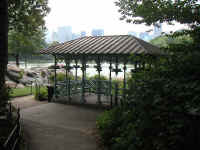 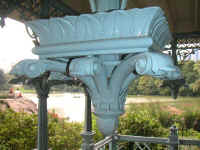 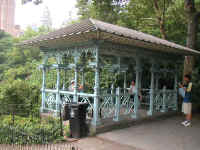 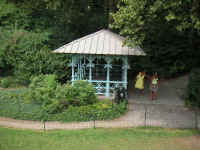 |
|
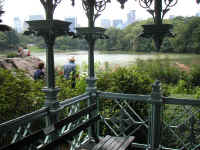 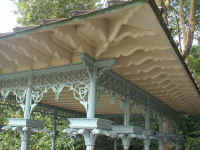 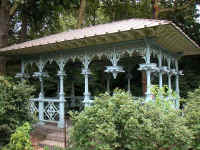 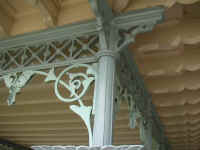 |
|
|
|
A Trolley Shelter is BornThe cast-iron shelter at Hernshead in Central Park known as the Ladies Pavilion was designed by Jacob Wrey Mould in 1871 to serve as a shelter for trolley passengers at the Eighth Avenue and 59th Street park entrance. This intersection, north of Manhattan's developed residential and commercial areas, became a transportation hub for Central Park visitors, many of whom had to travel great distances from their homes to enjoy the park's offerings. Although the shelter apparently was not located within the park proper, the Central Park Commissioners recognized the importance of facilitating travel to the park in order to increase visitorship. To this end, the Commissioners oversaw the construction of shelters to protect passengers from inclement weather and harsh sun as they waited for vehicles to take them home after a visit to Central Park. Original AppearanceAn account of work undertaken between April 1871 and June 1872 noted that, "The ombre, or sheds for passengers in waiting, at Eighth avenue and at Fifth avenue entrances, completed." The only surviving original drawing of a passenger shelter is Mould's February 1871 working drawing, entitled "Ombra For Passengers In Waiting." While it is unclear whether the Fifth Avenue shelter was based on this drawing, the Ladies Pavilion that currently stands on Hernshead certainly was. The drawing shows elevations and sections, details of the ridge crest, arcade frieze, railings, columns, and slate roof patterns, as well as plans for the ground and the soffit framing. The drawing is rendered in black and red ink with color washes that may hint at the color scheme of the completed structure. The shelter is shown elevated on a sandstone or molded iron base, with a plank floor and wooden roof beams. The majority of the ironwork is rendered in a slate blue wash, with muted blue green accents in the railing diagonals between the columns and the arcade frieze foliage motifs. Above this frieze rises a polychrome hipped slate roof with the following color scheme: A narrow green row at the eaves followed by a narrow red row, a narrow green row, a wide slate blue row, a narrow green row, a wide slate blue row, a narrow green row, a narrow red row, topped by a narrow green row. Muted blue green corner flashing compliments the accent color of the ironwork, while the design of the slate blue roof cresting echoes that of the arcade frieze. The cresting terminates with finials supported by brass or gold leaf balls. The original plan shows no seating, but given the probability of unpredictable travel schedules, movable benches may have been provided. Move to the LakeThere is no consensus on the date when the Ladies Pavilion assumed its present-day location on Hernshead. While a recent New York Times article gives a vague 1930s move date, and others give a much earlier 1904 date, it seems most likely that the shelter was moved to make way for the Maine Monument, constructed at the Columbus Circle entrance between 1912-13. Although the Ladies Pavilion is not original to its present site, Hernshead historically was home to the Ladies Cottage, a structure of another variety. The Ladies Cottage was most likely an enclosed preparation area for women ice skaters who had the option to exercise on the Lake proper, or on the segregated, more discreet Ladies Pond area of the Lake north of Hernshead. It is unclear what became of this original structure, but, according to historian Eugene Kinkead, the Ladies Pavilion continued to serve the same function for women skaters once it took over the site. The popularity of skating on the Lake well into the middle of the twentieth century, and the care taken to move the Ladies Pavilion rather than demolish it suggests that it was well-used and appreciated by park patrons. Twentieth-Century NeglectWith a string of warm winters and the construction of the Wollman ice skating rink in the lower park in 1950, the Ladies Pavilion's good fortune began to wane. Robert Moses' rampant modernizations rendered the Lake quaintly redundant as a skating area. By the late 1960's, the Ladies Pavilion had fallen into a state of severe disrepair due to years of deferred maintenance. Fortunately, the precarious condition of the Ladies Pavilion did not go unrecognized by the public, and according to Ada Louise Huxtable, "By 1969, there had been enough of an outcry from park groups and preservationists for the city to undertake restoration plans for the Pavilion." The non-profit organization Friends of Central Park raised funds through the Greensward Foundation to enable the architectural firm of Adams and Woodbridge to conduct a conditions assessment and prepare restoration drawings. Joseph Bresnan, Director of Monuments for the Parks Department, was then to facilitate the actual restoration work through the Parks Department's Capital Development Program. In April 1970, Adams and Woodbridge concluded, not surprisingly, that a new foundation and platform were necessary, as was extensive ironwork replacement, roof repair, and ground work. Actual work on the Ladies Pavilion, however, became mired in New York City Department of Parks and Recreation construction bidding bureaucracy that was ill-prepared to accommodate the project's need for specialized restoration craftsmen. Construction funds were not made available, and deterioration continued. In the meantime, vandals took the delay as an opportunity to knock down the ever-weakening Ladies Pavilion in September 1971. The pieces of the Ladies Pavilion that could be salvaged lay in storage as decaying testimony to the inefficiency of city government for several months. Restoration BeginsFinally, funds were available, craftsmen were hired, and in July 1972, iron monger Hermann Wiemann of Montvale, New Jersey presented Joseph Bresnan with his restoration proposals. During the winter of 1972-73, the masonry terrace around the Ladies Pavilion site was completed. Nine months and five hundred cast elements later, the nine by fifteen foot, two ton structure was ready for reassembly. The pavilion was anchored with steel rods sunk into the three and a half foot deep concrete foundation to thwart future vandals. The new foundation was faced with Manhattan schist coping stones salvaged from the remains of a comfort station foundation near the Dairy. Salvageable iron elements, sandblasted foundation stones, and bluestone steps were integrated into the restored structure, as was the original roof cresting. The Ladies Pavilion was fitted with a new wooden hipped roof with three foot eaves supported by ornamental rafters and covered with batten monel metal. Finally, the ironwork was painted blue-gray, with charcoal handrails and gold leaf accents. The total outside costs of the project came to only $21,000 because Parks Department personnel carried out the majority of the work; work that a contractor would have charged an estimated $70,000 to complete. The Ladies Pavilion restoration marked the first of many public-private partnership projects in the park, and its success was celebrated at an opening ceremony on October 30, 1973. Promises Fade, Requiring Further RestorationAt the 1973 opening ceremony, Donald Simon, the Director of the recently created Division of Historic Parks and Preservation, promised to, "...provide the kind of continuous maintenance and do the types of repairs that will correct most of the problems before extensive deterioration or aging takes place and large-scale work is required." Good intentions aside, by 1979 the Ladies Pavilion was showing signs of deterioration attributed to lakeside weather and the work of vandals who had made off with the tempting golden roof finials and smaller elements. Once again, the private sector came to the rescue, this time in the form of a $7,000 contribution from the Arthur Ross Foundation through the Friends of Central Park. Mr. Ross felt his money well-spent, commenting, "I am especially delighted to note the connection between the Ladies Pavilion, the Ladies Skating Pond and the role that Central Park has played as a milestone in the Women's Liberation Movement." The Ladies Pavilion was, "...painted a soft blue-green with gold trim." Specifically, according to Joseph Bresnan, the 1973 and 1979 restorations used Dutch Boy paints: Blue-gray "Oak Hall," No. 152/F for the overall ironwork, dark gray "Charcoal," No. 30/H for the handrails, "Soft Grey," No. 30/A for the wood ceiling, and Pittsburg Hastings XX Patent 23K on Quick Drying Gold Size for the gold leaf. Although the completion of the restoration was announced on September 26, 1979, it was not until late 1980 that Hermann Wiemann completed the replacement cresting finials, at which time they were installed by the Monument Restoration Staff. The Ladies Pavilion received its most recent attention in 1983-1984 when masonry and roof repairs were undertaken and missing ornamental ironwork elements were replaced. At this time, preservationist Marie Sarchiapone altered the paint color scheme from that chosen in the 1973 and 1979 restorations to one more closely resembling the original colors rendered by Mould. Dutch Boy paints were used: Medium grey "Roanoke," No. 151/E for the majority of the ironwork, light green "Veilgreen," No. 46/F for the arcade frieze foliage and railing diagonals, and "Soft Grey," No. 30/A for the wood ceiling. The large cresting finials were gold leafed. The Ladies Pavilion TodayToday, the Ladies Pavilion maintains its historic function as a shelter, used by park visitors as a vantage point from which to view the Lake. While the landscape around the Ladies Pavilion is maintained by funds from a private foundation, making Hernshead a popular and pleasant destination, lack of cyclical maintenance of the structure itself has resulted in by-now familiar deterioration patterns. Elements are missing, particularly from the arcade frieze foliage, and the paint has worn down to the metal in several areas leaving the structure vulnerable to more serious structural damage. Given its long and popular presence in Central Park, the Ladies Pavilion deserves yet another restoration, but the key to its longevity will lie in the continued routine attention of New York City Department of Parks and Recreation and Central Park Conservancy maintenance crews. Joanna Oltman |
|
links |
www.civilcity.org thanks to www.centralpark2000.com & www.centralparknyc.org |